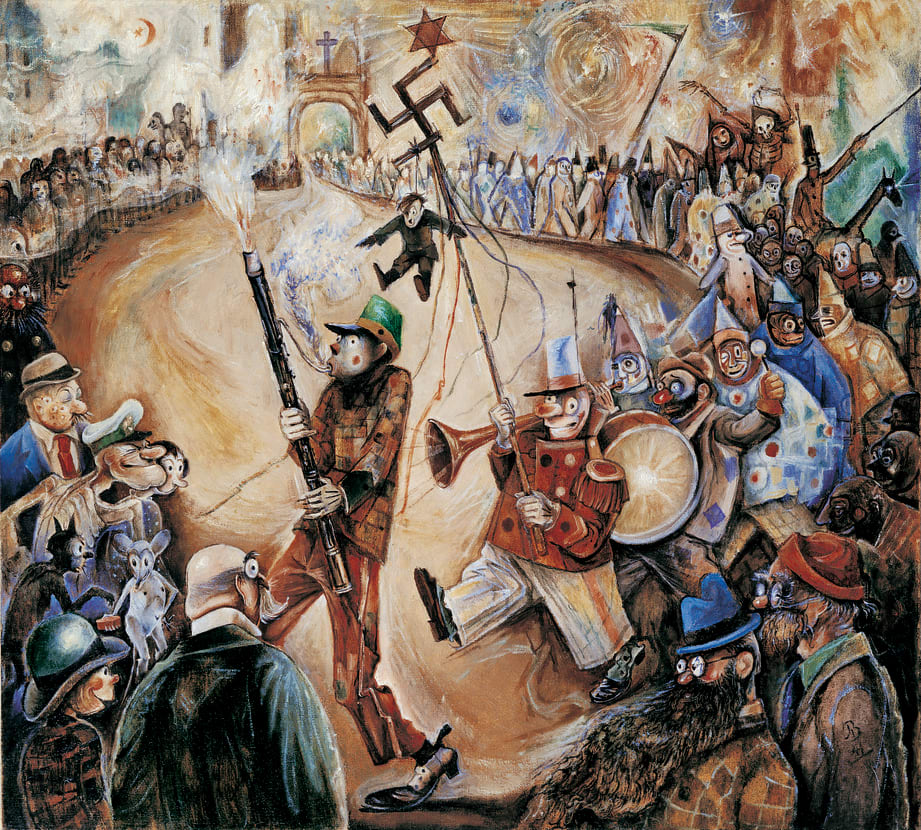
- Artist/Maker:
- Albert Bloch
- Bio:
- American, 1882-1961
- Title:
- March of the Clowns
- Date:
- 1941
- Medium:
- Oil on canvas mounted on composition board
- Dimensions:
- 36 × 40 in. (91.4 × 101.6 cm)
- Credit Line:
- Purchase: Oscar and Regina Gruss Memorial Fund
- Accession Number:
- 2001-42
Not On View
In Albert Bloch's March of the Clowns, the ribbons of a maypole cascade alongside a startled effigy of Hitler that hangs from a swastika. On one of the corners of the Nazi symbol's four arms balances a gleaming Star of David. In 1941, at the height of World War II, Bloch brought to life his fantasy about the defeat of Nazi Germany in a darkly comical way. Amid an ephemeral atmosphere of swirling constellations parade a seemingly infinite procession of clowns that seems at once ecstatic, morose, and sinister. The leader of the band plays a bassoon, often called the "clown of the orchestra," that emits smoke, obscuring the viewer's vision of the figures and buildings in the background. Music played an integral role in Bloch's work, and one can almost imagine the racket created by the bassoon, drums, and trumpet. Bloch's wife once wrote in an unpublished letter to The Jewish Museum, "I never look at March of the Clowns without hearing the final variation of Brahms' Variations on a Theme by Haydn, a huge, glorious and victorious march ending the piece."
Bloch was the only American-born member of Der Blaue Reiter, or the Blue Rider, a group of artists founded by Wassily Kandinsky and Franz Marc in Germany in 1911. Bloch met these two artists upon his first visit to Munich, and they included six of his paintings in the group's first exhibition. The Blue Rider, which also included Paul Klee and August Macke, strove to express personal and distinct senses of spirituality through abstracted depictions of nature.
The politically charged subject matter and illustrational style of March of the Clowns may seem like a departure from the enigmatic works that pervaded the Blue Rider. However, Bloch's first foray into the visual arts was as an illustrator of so-called kindly caricatures of artists, performers, and writers-including Rudyard Kipling and Gustav Mahler-for the Mirror, a satirical paper in his hometown of St. Louis. He lived alternately in Europe and the United States until 1923, when he obtained a professorship in the Department of Painting and Drawing at the University of Kansas in Lawrence, which he held until his retirement in 1947.
Bloch painted March of the Clowns in 1941, while living in Kansas, and most likely before the United States entered the war. The parade's spectators are cartoon characters from the 1920s and 1930s, including Popeye, Olive Oyl, Krazy Kat, and Ignatz Mouse, all on the left side of the picture. In the foreground are characters that may be from the Katzenjammer Kids or Moon Mullins cartoons. Cross-cultural signs and symbols are strewn throughout the image. These include: an arch, historically a symbol of power and triumph; a cross, the icon of Christianity; a crescent moon and star, which have become the symbol of Islam; and festive-looking skeletons, often associated with the Mexican Day of the Dead. Perhaps the positions of the cartoon characters, so strongly identified with American culture, standing at the periphery of this procession of ghoulish creatures, mirror Bloch's feeling of isolation and powerlessness as he watched World War II unfolding overseas.
Bloch was the only American-born member of Der Blaue Reiter, or the Blue Rider, a group of artists founded by Wassily Kandinsky and Franz Marc in Germany in 1911. Bloch met these two artists upon his first visit to Munich, and they included six of his paintings in the group's first exhibition. The Blue Rider, which also included Paul Klee and August Macke, strove to express personal and distinct senses of spirituality through abstracted depictions of nature.
The politically charged subject matter and illustrational style of March of the Clowns may seem like a departure from the enigmatic works that pervaded the Blue Rider. However, Bloch's first foray into the visual arts was as an illustrator of so-called kindly caricatures of artists, performers, and writers-including Rudyard Kipling and Gustav Mahler-for the Mirror, a satirical paper in his hometown of St. Louis. He lived alternately in Europe and the United States until 1923, when he obtained a professorship in the Department of Painting and Drawing at the University of Kansas in Lawrence, which he held until his retirement in 1947.
Bloch painted March of the Clowns in 1941, while living in Kansas, and most likely before the United States entered the war. The parade's spectators are cartoon characters from the 1920s and 1930s, including Popeye, Olive Oyl, Krazy Kat, and Ignatz Mouse, all on the left side of the picture. In the foreground are characters that may be from the Katzenjammer Kids or Moon Mullins cartoons. Cross-cultural signs and symbols are strewn throughout the image. These include: an arch, historically a symbol of power and triumph; a cross, the icon of Christianity; a crescent moon and star, which have become the symbol of Islam; and festive-looking skeletons, often associated with the Mexican Day of the Dead. Perhaps the positions of the cartoon characters, so strongly identified with American culture, standing at the periphery of this procession of ghoulish creatures, mirror Bloch's feeling of isolation and powerlessness as he watched World War II unfolding overseas.
Information may change as a result of ongoing research.